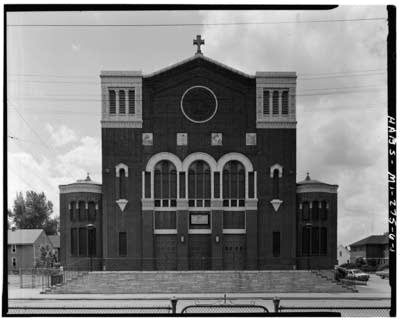How the closings of two auto plants changed Hamtramck and Detroit’s Poletown
When the Dodge Main plant closed in 1979, local leaders offered GM tax breaks and more land to move in. Now the GM plant is closing, too.

Celso Duque spent a recent summer day attaching doors to the bodies of sedans made at General Motor’s Detroit-Hamtramck Assembly plant, where he’s worked for 22 years. Until early June, he was president of United Auto Workers Local 22, but he decided not to run for reelection after GM announced plans to idle the plant in 2020.
Duque moves from task to task — wherever he’s needed in the factory — as its workforce has dwindled. His colleagues are transferring to other GM plants or leaving to retrain in other fields.
Last year at this time, he said “D-Ham,” as the plant is known, employed about 1,500 hourly workers. It’s now down to about 800. The plant no longer makes the Chevy Volt, and GM is discontinuing the other two vehicles the plant produces, the Chevy Impala and the Cadillac CT6. The move is part of an industrywide pivot away from sedans to more popular and profitable SUVs. Detroit-Hamtramck is one of four factories GM will close this year as part of an ongoing effort to save $6.5 billion in operating costs.

Duque said the word that describes what he felt when he found out last fall that D-Ham would close is disappointment.
“Everything they’ve asked us to do at this plant, we’ve done it,” he said. “A year ago, we were building four different models. We’re probably the most complex builds of all of GM.”

Duque’s father worked for GM, too. But he was laid off for the better part of Duque’s childhood. He waited tables at a local restaurant to support his family of five until finally getting called back to the factory a decade after getting his pink slip.
“We grew up poor, but we weren’t starving,” Duque said. “He put in a lot of hours, and my mother had to make sacrifices to make sure we had what we needed.”
Watching his father weather the ups and downs helped prepare Duque for his own career in the auto industry. He said the money is tough to beat, but the fear of being laid off has pushed him to squirrel away enough savings to support himself in the short term. The one thing he didn’t expect, however, was that D-Ham would close altogether.
“This plant’s not old, built in the ’80s, so you’d figure it still had another 50 years to go,” he said.
Duque isn’t the only one who’s surprised by GM’s decision to close the plant.
When it was completed in 1985, it was the first new factory GM had built in 50 years. The automaker touted it as a technological marvel. But it will close after just 35 years in service. That’s more than 20 years less than the average lifespan of GM assembly plants.

Duque said Detroit has come a long way in the past decade, and he’s worried about the economic ripple effects his hometown will suffer when the lights go out in early 2020.
“That’s a lot of tax money that’s going to be eliminated from the area and a lot of money that used to be spent at restaurants, movies and bowling alleys. Losing good-paying jobs is just going to be a big blow for the area.”
Duque is also afraid of the bigger picture all of GM’s recent factory closures paint for the national economy. He points out that organized labor has deep roots in Detroit, and its survival there is paramount to its survival everywhere.
“We’re having more and more of these high-paying jobs leaving,” he said. “It’s leading to the erosion of the middle class. What are we going to be in another 50 years? We’re in a battle not just for ourselves, but for the livelihood of America.”
But this particular story in Detroit is about much more than the loss of the jobs at D-Ham, economic ripple effects or the decline of unions. It’s about the relationship between corporations and communities, and the sacrifices those communities make for the promise of jobs. Because D-Ham isn’t the first plant on the site to be closed by an automaker; Detroit and Hamtramck have been through this before.
The history
If you look at a map of the city of Detroit, you’ll see this polygonal cutout in the center, sort of like an 8-bit doughnut hole. It’s two independent cities — Highland Park and Hamtramck.

Both were built by the auto industry. Highland Park is where Henry Ford started the Ford Motor Co., and Hamtramck is where the Dodge brothers began building their own factory, Dodge Main, in 1911 after they broke off from Ford.

The opening of the Dodge Main plant drew thousands of Polish immigrants to the then-village of Hamtramck. Worries that Detroit would annex the hamlet and impose higher taxes prompted Dodge to push for it to incorporate. To this day, Hamtramck remains a 2-square-mile independent city, surrounded by Detroit, and now home to around 22,000 people.
By the late 1970s, the U.S. auto industry was beset by problems: The energy crisis, a recession, increased foreign competition and a string of quality and safety snafus. Detroit automakers, including Dodge’s parent Chrysler, suffered record losses. The company announced it would close Dodge Main in 1979.
The plant “provided about a quarter of Hamtramck’s operating revenue in taxes,” said Greg Kowalski, who runs the Hamtramck Historical Museum. “When the plant closed, we lost that revenue, and we didn’t know what the heck we were going to do. How do we replace that and where?”
On the other side of the plant, Detroit was in the midst of its own battle for survival. The city was still reeling from race riots and white flight. By 1980, it had lost a third of its tax-paying residents. Crime was on the rise, unemployment was hovering around 20% percent, and its tentpole industry was on the ropes.
Salvation appeared on the horizon just a few months after Dodge Main closed, when GM told officials it wanted to build a $500 million factory in Detroit that it said would create as many as 6,000 jobs.
But GM threatened to take the project to the South or even to Mexico if it didn’t get tax incentives and more land to expand the almost 70-year-old plant.
The cities of Detroit and Hamtramck were desperate to win the deal. They strung together $350 million in local, state and federal tax enticements (around $1 billion in today’s dollars) and offered to seize a 465-acre plot on the Detroit side of the border adjacent to Dodge Main by eminent domain.
But that land wasn’t empty. It encompassed nearly all of a neighborhood called Poletown.
Eminent domain
Eminent domain is the government’s constitutional right to take private property for “public use” if the property owner is compensated. The city of Detroit’s plan was to use eminent domain to bulldoze 1,500 homes, 144 businesses, 16 churches and a hospital and give the land to GM for the expanded assembly plant. Roughly 3,500 residents would be displaced.
The plan had broad support. The UAW backed it, and local media wrote glowing editorials. Even the Catholic Archdiocese was on board, despite the fact that several historic churches would be wiped out.
The average payout the city of Detroit offered for homes was $13,000. Some residents got more to cover relocation and expenses. And some residents were happy to take the money and move on.
But a small and vocal opposition group called the Poletown Neighborhood Coalition refused. Some of its members had lived in the community their entire lives; no amount of money was enough to convince them to make the move. A Poletown native named Louise Crosby made her succinct case to CBS News cameras at the time:
“This is my life. If I have to leave here I may as well be dead. “
“When this all was happening back in the early 1980s, it was a wild time. It really was,” said Kowalski of the Hamtramck Historical Museum. “There were protests. There were marches. And Ralph Nader came to town.”
Detroit Mayor Coleman Young defended the plan in an interview with CBS News in 1981.

“When you have to strike a balance, you have to strike a balance in favor of life and jobs as opposed to a slow death,” Young said. “Are the jobs proposed for the city of Detroit and General Motors in the public interest? I say the answer to that question is yes.”
The Poletown Neighborhood Coalition filed suit against the city of Detroit, saying its use of eminent domain to take private land for the private use of a company was unconstitutional. The case went all the way to the Michigan Supreme Court. (Click here to see photos of Poletown during the protests.)
The decision
James L. Ryan is a former federal appeals judge appointed by President Ronald Reagan. He served 47 years on the bench, a decade of which was spent on the Michigan Supreme Court.
Ryan, who’s now 86, said he spends much of his time these days at his home in suburban Detroit reflecting on his work, and one of his highest-profile cases was Poletown. He is one of two surviving judges who ruled on it.
“This isn’t such a common business for the government to enter into a deal with a private enterprise and to have a property condemned,” Ryan said. “That only occurred here because of the happy notion among many good citizens in Michigan that if the city cooperates with General Motors to build this huge plant, everybody will be happy. The unemployed go to work, the economy will be boosted, collateral satellite businesses will be established. It’s hard to bet against that.”
But Ryan did bet against it. As one of the court’s more conservative members, he authored the dissent in a 5-2 opinion.
“I didn’t see it as a good guy versus bad guy issue at all,” Ryan said. “I saw it as an almost hypertechnical lawyer’s blue book final exam issue. Does ‘benefit’ mean ‘use?’ The Constitution says you can take property for ‘public use’ — a fire station, a police station. But you can’t take it for ‘benefiting’ the public. I thought the court was bending the word ‘use’ to [mean] ‘benefit.’ “
The demolition
Ultimately, the Michigan Supreme Court upheld Detroit’s right to use eminent domain to seize Poletown. On July 14, 1981, news cameras captured Detroit police bursting through the doors behind the altar of Immaculate Conception Church to clear out the 20 remaining protesters, ending a 29-day sit-in. Twelve people were arrested, including the church’s pastor, Rev. Joseph Karasiewicz, who had become the face of the resistance. Demolition of the church began the same day. Parishioners sang hymns outside as the wrecking ball did its work.

The aftermath
On a rainy summer day, Tom Olechowski gave us a tour of Poletown — or what’s left of it.
Part of the neighborhood survived — it’s called Poletown East, and Olechowski’s been living in a home he bought there a few years before the plant was built. He was born and raised in Poletown and says his childhood was a testament to the neighborhood’s ethnic roots.
“We had newspapers in Polish. In school, we learned to speak, read and write Polish. I didn’t learn to speak English until I was playing with kids on the street when I was 4 or 5 years old.”
Olechowski, who is now in his 80s, was the head of the Poletown Neighborhood Coalition. His name is on the lawsuit filed to stop construction of GM’s plant back in 1981. He said he had been making efforts to help revitalize Poletown when Detroit announced its plan to condemn it.
“That section that GM took for building the plant was the most diverse section in the whole area,” Olechowski said. “There were Latino people, Appalachian folks, Native Americans, black people, Polish people, Russian people, all kinds of folks, and they all got along beautifully. And that’s the greatest crime of all. The whole damn thing was just wiped out as if it were debris. As if it were not an organic living, breathing, pulsating, caring human community. For people who were lower-middle class, working class or in poverty, to them it was a great place to be, and it was about to be destroyed by a corporation.”
There is a main thoroughfare that once connected Poletown and Hamtramck. On the Hamtramck side, it’s called Joseph Campau Avenue. On the Detroit side, it’s Chene Street.
Today, the Hamtramck side is vibrant and full of businesses, with 57 restaurants and 66 grocery stores, according to Kowalski at the Hamtramck Historical Museum.
Olechowski said before the factory was built, the Chene side was the same. But now, the road dead-ends into a chain-link fence surrounding the GM plant.
“This street was the epicenter of Poletown. Every lot you see here, there was a bar, a restaurant, a cleaners, a dentist. There was a city market here many years ago, a big thriving one, and now it’s all gone. It’s a wreck now. It’s a ruin. It’s fields.”

Along the street, dilapidated buildings crumble alongside urban prairies. This is not unlike the rest of Detroit, where “ruin porn” has become a signature of the city.
But Olechowski said Poletown was different. He contends that despite dwindling congregations by the early 1980s, Poletown’s churches formed a tight-knit community that gave the neighborhood a unique viability. He believes Detroit simply didn’t have the political will to invest in fixing up a neighborhood of low-income residents.
“‘Rundown’ depends on who you’re talking to, right? You could easily say my house is rundown, and to a great degree it is. But there’s nothing wrong with my house that 20,000 of today’s dollars couldn’t bring right up to snuff, you know?”
Looking forward
Karen Majewski runs a vintage clothing store named Tekla on Hamtramck’s main drag, Joseph Campau Avenue. She also runs the city: She’s been Hamramck’s mayor since 2005.
Majewski came to this area long after the Poletown fiasco, so she never had to deal with the protests over the construction of GM’s plant, but she has had to deal with protests and has organized town halls regarding its closure. The plant may have led to Poletown’s demise, but just over the border, it has been a lifeline for Hamtramck over the past four decades.
“Just kind of dispassionately, the creation of that plant did not work out badly for the city of Hamtramck,” Majewski said. “But I don’t know how you measure the loss of thousands of people, of populations, of families, of all those businesses that went away, institutions that kind of anchor and create cohesion for a community. And you know, we can say, ‘Well that was on the other side of the border,’ right? But our borders are porous, and we even share a ZIP code, so the loss of that neighborhood probably had much bigger economic impacts than maybe are measurable.”
Today Hatramck finds itself at a crossroads that is nearly identical to the one it faced 40 years ago when the Dodge Main plant closed.
“The GM plant is one of our biggest taxpayers and accounts for about $850,000 on average out [of] a $16 million budget, so it’s substantial and there’s no replacing it,” Majewski said. “There’s no, ‘Oh well, there’s the other plant on the other side of town,’ right? There is no other plant on the other side of town. This is really substantial for us, and it’s the kind of loss that can sink a small city like ours.”
Hamtramck is a much different city today than it was in 1979. Majewski said very few of the employees at GM’s plant live in Hamtramck. Most, she said, commute from the suburbs or other parts of Detroit. Hamtramck residents are also no longer primarily of Polish descent. Instead, they’re incredibly diverse. In the 1990s, the city’s Muslim population increased fivefold, with immigrants from Yemen, Bangladesh and Bosnia. That shift has helped usher in an entirely new economy, one that Majewski hopes will help her city bounce back again.
But Majewski said she’s nervous about what will happen to the Poletown plant once it closes. Detroit was built by the auto industry, but it’s also littered with its refuse. Just a mile away from the fence of Detroit-Hamtramck, the eerie, post-apocalyptic ruins of the Packard Plant have become a potent symbol of Detroit’s struggles. It shut down in 1958 and has been rotting there ever since. Majewski worries that the factory in her backyard could suffer a similar fate.

Was it worth it?
Judge James L. Ryan said he’s thought a lot about the Poletown decision’s human ramifications over the years. He recalls a time a few years after the plant had been built when he visited a friend’s brand new office in the Fisher Building, one of Detroit’s tallest skyscrapers. From 25 stories up, Ryan looked east and saw a big, empty plot. It was the Poletown plant. The buildings took up just one-sixth of the total land behind the fence. The rest was pavement.
“[There were] miles and miles of concrete parking lot around the place and there’s a relative handful of cars parked there. I said, ‘Is this a working day?’ And [his friend] said, ‘Yeah.’ And I said, ‘Well, I don’t understand where all the [6,000] employees are?’ And he said, ‘Jim, this is a robotics plant.’ Which triggered in my mind the memory that the lawyers argued vigorously that this was a public benefit because of a great number of workers who would be employed. Well, it didn’t turn out that way.”
Detroit-Hamtramck Assembly was a product of its time, a state-of-the-art facility GM would tout as the future of auto manufacturing. Employment at the plant peaked at around 3,000 workers, half of what the sales pitch had promised, and for many years it operated with 1,500.
So was 1,500 homes for 1,500 jobs a good trade?
In 2004, the state of Michigan decided it wasn’t. It overturned the Poletown decision, and a later ballot measure turned Michigan into one of the most restrictive eminent domain states in the country.
But in those 24 years on the books, the Poletown ruling had been used to justify similar seizures of private land for the private use of corporations in other places across the country.
Special thanks to the late journalist and author Jeanie Wylie, whose book “Poletown: Community Betrayed” was used a source for this article.









































